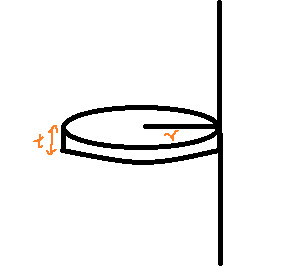
Calculate the radius of gyration of the disc of radius r and thickness t about a line perpendicular to the plane of this disk and tangent to the disk as shown in the figure.

Answer
219.6k+ views
: Hint: The radius of gyration is defined mathematically as the root mean square distance of the object parts from the center of mass or a given axis. We can calculate the radius of gyration if we know the moment of inertia and the total mass of the body.
Complete step by step answer:
So in the question we are given a circular disc of radius r and thickness t. Suppose this disc has a density $\text{ }\!\!\rho\!\!\text{ }$ associated with it and the volume of the disc is given by, $\text{V}=\text{ }\!\!\pi\!\!\text{ }{{\text{r}}^{\text{2}}}\text{t}$.
So the total mass of the disk can be written as, $\text{M}=\text{ }\!\!\rho\!\!\text{ V}$, which is equal to,
$\text{M}=\text{ }\!\!\rho\!\!\text{ }\left( \text{ }\!\!\pi\!\!\text{ }{{\text{r}}^{\text{2}}}\text{t} \right)$ …equation (1)
So the moment of inertia of any body can be written as,
\[\text{I}=\text{M}{{\text{K}}^{\text{2}}}\]
Where,
I is the moment of inertia
M is the total mass of the body
K is the radius of gyration
So the radius of gyration of any extended body can be written as,
$\text{K}=\sqrt{\dfrac{\text{I}}{\text{M}}}$ ….. equation (2)
Suppose we have an axis that passes perpendicular to the center of the disc.
The moment of inertia of a circular disc of radius R is given by,
$\text{I}=\dfrac{\text{M}{{\text{R}}^{\text{2}}}}{2}$ … equation (3)
Substituting the values of I and M from equation (1) and (3) respectively in equation (2), we get
$\text{K}=\sqrt{\dfrac{(\text{M}{{\text{r}}^{\text{2}}})/2}{\text{ }\!\!\rho\!\!\text{ }\!\!\pi\!\!\text{ }{{\text{r}}^{\text{2}}}\text{t}}}=\sqrt{\dfrac{\text{M}{{\text{r}}^{\text{2}}}}{\text{2M}}}$
$\therefore \text{K}=\dfrac{\text{r}}{\sqrt{2}}$
So the radius of gyration along an axis which is perpendicular to the disc is given by $\text{K}=\dfrac{\text{r}}{\sqrt{2}}$.
Suppose we have an axis that passes as a tangent to the disc as shown in the figure.
Using the parallel axis theorem, the moment of inertia of a circular disc of radius R along a tangent to the disc is given by,
$\text{I}=\dfrac{\text{M}{{\text{R}}^{\text{2}}}}{2}+\text{M(R}{{\text{)}}^{\text{2}}}$ … equation (4)
Substituting the values of M and I from equation (1) and (4) respectively in equation (2), we get
$\text{K}=\sqrt{\dfrac{(3\text{M}{{\text{r}}^{\text{2}}})/2}{\text{ }\!\!\rho\!\!\text{ }\!\!\pi\!\!\text{ }{{\text{r}}^{\text{2}}}\text{t}}}=\sqrt{\dfrac{\text{3M}{{\text{r}}^{\text{2}}}}{\text{2M}}}$
$\therefore \text{K}=\text{r}\sqrt{\dfrac{\text{3}}{\text{2}}}$
So the radius of gyration along an axis which is tangent to the disc is given by $\text{K}=\text{r}\sqrt{\dfrac{\text{3}}{\text{2}}}$.
Note: The radius of gyration is also called gyradius. It can also be defined as the radial distance to a point that would have a moment of inertia the same as the body's actual distribution of mass if the total mass of the body were concentrated.
The moment of inertia is an analog to mass in rotational dynamics.
Complete step by step answer:
So in the question we are given a circular disc of radius r and thickness t. Suppose this disc has a density $\text{ }\!\!\rho\!\!\text{ }$ associated with it and the volume of the disc is given by, $\text{V}=\text{ }\!\!\pi\!\!\text{ }{{\text{r}}^{\text{2}}}\text{t}$.
So the total mass of the disk can be written as, $\text{M}=\text{ }\!\!\rho\!\!\text{ V}$, which is equal to,
$\text{M}=\text{ }\!\!\rho\!\!\text{ }\left( \text{ }\!\!\pi\!\!\text{ }{{\text{r}}^{\text{2}}}\text{t} \right)$ …equation (1)
So the moment of inertia of any body can be written as,
\[\text{I}=\text{M}{{\text{K}}^{\text{2}}}\]
Where,
I is the moment of inertia
M is the total mass of the body
K is the radius of gyration
So the radius of gyration of any extended body can be written as,
$\text{K}=\sqrt{\dfrac{\text{I}}{\text{M}}}$ ….. equation (2)
Suppose we have an axis that passes perpendicular to the center of the disc.
The moment of inertia of a circular disc of radius R is given by,
$\text{I}=\dfrac{\text{M}{{\text{R}}^{\text{2}}}}{2}$ … equation (3)
Substituting the values of I and M from equation (1) and (3) respectively in equation (2), we get
$\text{K}=\sqrt{\dfrac{(\text{M}{{\text{r}}^{\text{2}}})/2}{\text{ }\!\!\rho\!\!\text{ }\!\!\pi\!\!\text{ }{{\text{r}}^{\text{2}}}\text{t}}}=\sqrt{\dfrac{\text{M}{{\text{r}}^{\text{2}}}}{\text{2M}}}$
$\therefore \text{K}=\dfrac{\text{r}}{\sqrt{2}}$
So the radius of gyration along an axis which is perpendicular to the disc is given by $\text{K}=\dfrac{\text{r}}{\sqrt{2}}$.
Suppose we have an axis that passes as a tangent to the disc as shown in the figure.
Using the parallel axis theorem, the moment of inertia of a circular disc of radius R along a tangent to the disc is given by,
$\text{I}=\dfrac{\text{M}{{\text{R}}^{\text{2}}}}{2}+\text{M(R}{{\text{)}}^{\text{2}}}$ … equation (4)
Substituting the values of M and I from equation (1) and (4) respectively in equation (2), we get
$\text{K}=\sqrt{\dfrac{(3\text{M}{{\text{r}}^{\text{2}}})/2}{\text{ }\!\!\rho\!\!\text{ }\!\!\pi\!\!\text{ }{{\text{r}}^{\text{2}}}\text{t}}}=\sqrt{\dfrac{\text{3M}{{\text{r}}^{\text{2}}}}{\text{2M}}}$
$\therefore \text{K}=\text{r}\sqrt{\dfrac{\text{3}}{\text{2}}}$
So the radius of gyration along an axis which is tangent to the disc is given by $\text{K}=\text{r}\sqrt{\dfrac{\text{3}}{\text{2}}}$.
Note: The radius of gyration is also called gyradius. It can also be defined as the radial distance to a point that would have a moment of inertia the same as the body's actual distribution of mass if the total mass of the body were concentrated.
The moment of inertia is an analog to mass in rotational dynamics.
Recently Updated Pages
Mass vs Weight: Key Differences Explained for Students

JEE Nuclear Chemistry Important Concepts and Tips for Exam Preparation

JEE Main College Predictor 2024: Find your college with JEE Main Score

Chemical Equilibrium – Introduction, Types, Factors and FAQs

JEE Main 2024 (January 25 Shift 2) Maths Question Paper with Solutions [PDF]

The Living World - Role of Different Substances and Taxonomic Categories

Trending doubts
Understanding Uniform Acceleration in Physics

JEE Main 2026: Application Form Open, Exam Dates, Syllabus, Eligibility & Question Papers

JEE Main Syllabus 2026: Download Detailed Subject-wise PDF

JEE Main Previous Year Question Papers (2014–2025) with Answer Keys and Solutions

Exothermic Reactions: Real-Life Examples, Equations, and Uses

JEE Main Marks vs Percentile vs Rank 2026: Calculate Percentile and Rank Using Marks

Other Pages
Essential Physics Formulas for Class 9: Complete Chapterwise List

Devuthani Ekadashi 2025: Know the Correct Date, Shubh Muhurat, and Parana Time

Quadratic Equation Questions: Practice Problems, Answers & Exam Tricks

Difference Between Exothermic and Endothermic Reactions Explained

Mahaparinirvana Diwas 2025: Significance, History, and Ways to Observe

Who is Lionel Messi? Biography, Awards & Achievements




